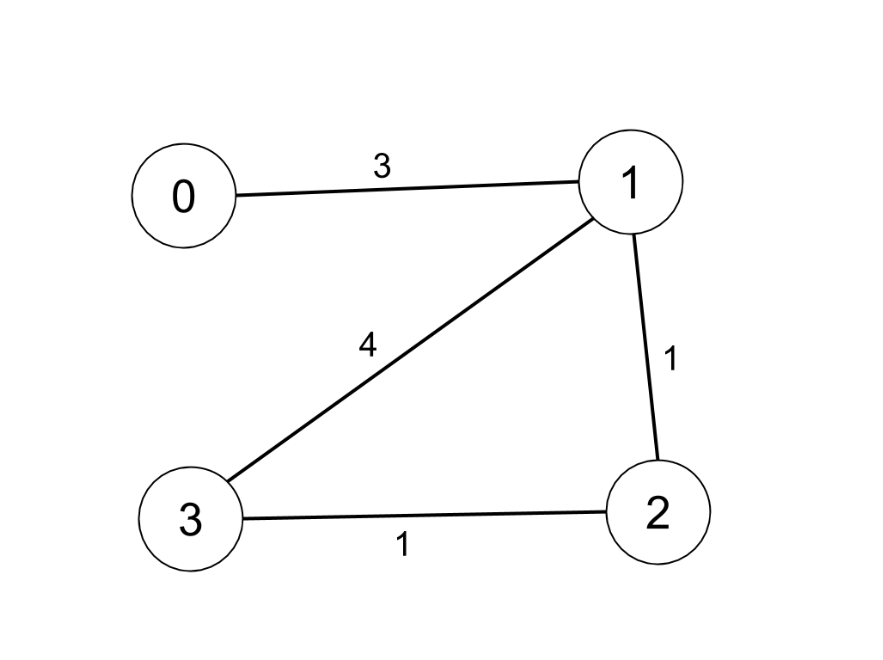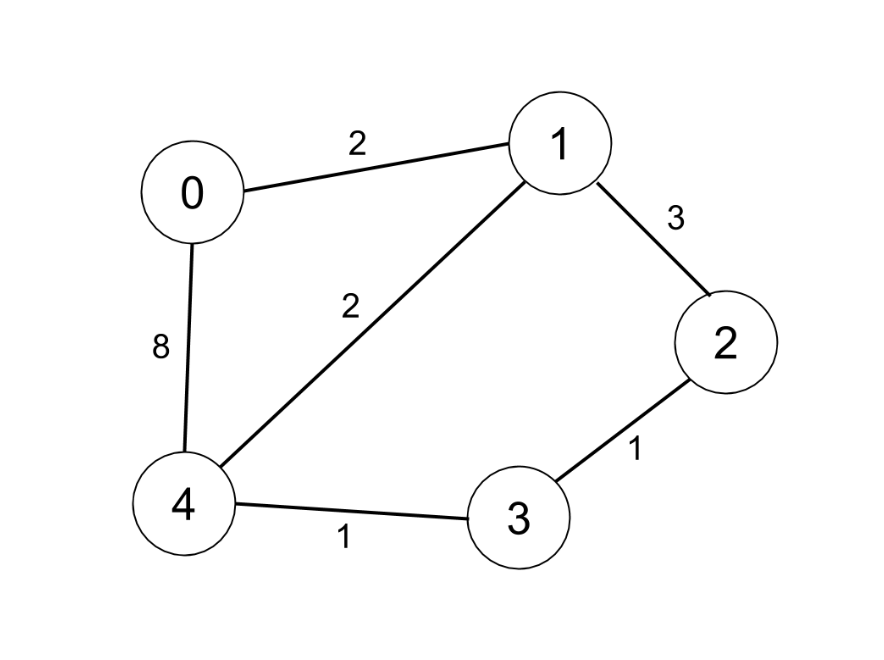- {x}
- Minimum Number of Taps to Open to Water a Garden
- List the Products Ordered in a Period
- Break a Palindrome
- Sort the Matrix Diagonally
- Reverse Subarray To Maximize Array Value
- Rank Transform of an Array
- Remove Palindromic Subsequences
- Filter Restaurants by Vegan-Friendly, Price and Distance
- Find the City With the Smallest Number of Neighbors at a Threshold Distance
- Minimum Difficulty of a Job Schedule
- Number of Transactions per Visit
- The K Weakest Rows in a Matrix
- Reduce Array Size to The Half
- Maximum Product of Splitted Binary Tree
- Jump Game V
- Movie Rating
- Number of Steps to Reduce a Number to Zero
- Read More...

Find the City With the Smallest Number of Neighbors at a Threshold Distance
There are n cities numbered from 0 to n-1. Given the array edges where edges[i] = [fromi, toi, weighti] represents a bidirectional and weighted edge between cities fromi and toi, and given the integer distanceThreshold.
Return the city with the smallest number of cities that are reachable through some path and whose distance is at most distanceThreshold, If there are multiple such cities, return the city with the greatest number.
Notice that the distance of a path connecting cities i and j is equal to the sum of the edges' weights along that path.
Example 1:

Input: n = 4, edges = [[0,1,3],[1,2,1],[1,3,4],[2,3,1]], distanceThreshold = 4 Output: 3 Explanation: The figure above describes the graph. The neighboring cities at a distanceThreshold = 4 for each city are: City 0 -> [City 1, City 2] City 1 -> [City 0, City 2, City 3] City 2 -> [City 0, City 1, City 3] City 3 -> [City 1, City 2] Cities 0 and 3 have 2 neighboring cities at a distanceThreshold = 4, but we have to return city 3 since it has the greatest number.
Example 2:

Input: n = 5, edges = [[0,1,2],[0,4,8],[1,2,3],[1,4,2],[2,3,1],[3,4,1]], distanceThreshold = 2 Output: 0 Explanation: The figure above describes the graph. The neighboring cities at a distanceThreshold = 2 for each city are: City 0 -> [City 1] City 1 -> [City 0, City 4] City 2 -> [City 3, City 4] City 3 -> [City 2, City 4] City 4 -> [City 1, City 2, City 3] The city 0 has 1 neighboring city at a distanceThreshold = 2.
Constraints:
2 <= n <= 1001 <= edges.length <= n * (n - 1) / 2edges[i].length == 30 <= fromi < toi < n1 <= weighti, distanceThreshold <= 10^4- All pairs
(fromi, toi)are distinct.
Solution Explanation
This problem asks to find the city with the smallest number of neighbors within a given distance threshold. The solution involves finding the shortest paths between all pairs of cities and then counting the number of cities reachable within the threshold from each city.
The most efficient approach uses Floyd-Warshall algorithm or Dijkstra's algorithm. Both algorithms are used to compute the shortest paths between all pairs of nodes in a graph.
Floyd-Warshall Algorithm: This algorithm is simpler to implement but has a higher time complexity of O(N³), where N is the number of cities. It works by iteratively considering all possible intermediate nodes in paths between pairs of cities.
Dijkstra's Algorithm: This algorithm is more efficient for sparse graphs (graphs with relatively few edges) with a time complexity of O(E log V), where E is the number of edges and V is the number of vertices (cities). It explores the graph by iteratively selecting the closest unvisited city and updating distances to its neighbors. However, in this problem, since we need the shortest path between all pairs, the solution will involve repeatedly running Dijkstra's Algorithm.
Both approaches will be explained below.
Approach 1: Floyd-Warshall Algorithm
-
Initialization: Create an adjacency matrix
grepresenting the graph whereg[i][j]stores the shortest distance between cityiand cityj. Initializeg[i][j]to infinity if there's no direct edge betweeniandj, and to the weight of the edge if there is one. Set the diagonal elementsg[i][i]to 0. -
Floyd-Warshall: Iterate through all possible intermediate nodes
kand update the shortest distances:g[i][j] = min(g[i][j], g[i][k] + g[k][j]). This step ensures that we consider all possible paths between citiesiandj, including those that pass through intermediate nodesk. -
Counting Reachable Cities: For each city
i, count the number of citiesjsuch thatg[i][j]is less than or equal to thedistanceThreshold. -
Finding the City: Iterate through the counts, keeping track of the city with the minimum number of reachable cities and choosing the one with the largest index if there's a tie.
Approach 2: Repeated Dijkstra's Algorithm
-
Initialization: Create an adjacency list or matrix representing the graph.
-
Repeated Dijkstra's: Run Dijkstra's algorithm for each city
ito find the shortest distances from cityito all other cities. -
Counting Reachable Cities: For each city
i, count the number of citiesjsuch that the shortest distance fromitojis less than or equal to thedistanceThreshold. -
Finding the City: Iterate through the counts, finding the city with the minimum number of reachable cities, and choosing the one with the largest index in case of a tie.
Time Complexity Analysis
- Floyd-Warshall: O(N³). The dominant operation is the triple nested loop in the Floyd-Warshall algorithm.
- Repeated Dijkstra's: O(N * (E log V)). Dijkstra's algorithm is run N times, once for each starting city.
Space Complexity Analysis
Both algorithms have a space complexity of O(N²), primarily due to the adjacency matrix used to store shortest paths. In the Dijkstra method, the adjacency list might use slightly less space in case of sparse graphs, however, the dominant factor is the distance matrix needed to store the results.
Code Examples (Python - Approach 1: Floyd-Warshall)
import sys
class Solution:
def findTheCity(self, n: int, edges: List[List[int]], distanceThreshold: int) -> int:
g = [[sys.maxsize] * n for _ in range(n)] # Initialize with infinity
for u, v, w in edges:
g[u][v] = g[v][u] = w # Bi-directional edges
for i in range(n):
g[i][i] = 0 # Distance to self is 0
# Floyd-Warshall algorithm
for k in range(n):
for i in range(n):
for j in range(n):
g[i][j] = min(g[i][j], g[i][k] + g[k][j])
min_neighbors = float('inf')
result_city = -1
for i in range(n):
reachable_neighbors = sum(1 for dist in g[i] if dist <= distanceThreshold)
if reachable_neighbors <= min_neighbors:
min_neighbors = reachable_neighbors
result_city = i
return result_city
The other languages (Java, C++, Go, TypeScript, JavaScript) would follow similar logic, but with their respective syntax and data structures. You would replace sys.maxsize with the appropriate representation of infinity for each language. The core Floyd-Warshall algorithm remains the same. The code provided in the original response shows both Floyd-Warshall and repeated Dijkstra solutions, choose the one that better suits your needs based on the expected size of the graph. For smaller graphs, Floyd-Warshall might be simpler to implement; for larger and sparser graphs, repeated Dijkstra is likely to be more efficient.